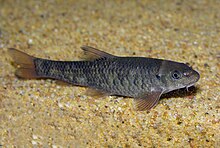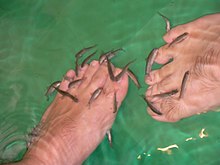Red garra
| Red garra | |
|---|---|

| |
| Scientific classification | |
| Domain: | Eukaryota |
| Kingdom: | Animalia |
| Phylum: | Chordata |
| Class: | Actinopterygii |
| Order: | Cypriniformes |
| Family: | Cyprinidae |
| Subfamily: | Labeoninae |
| Genus: | Garra |
| Species: | G. rufa
|
| Binomial name | |
| Garra rufa (Heckel, 1843)
| |
| Synonyms | |
The red garra (Garra rufa), also known as the doctor fish or nibble fish, is a
In the wild, Garra rufa feed on detritus, algae and tiny animals (arthropods and other zooplankton).[5] Since the early 21st century, this fish has been integrated into a spa treatment where they feed on the stratum corneum skin layer of patients with psoriasis. While the doctor fish treatment has been found to alleviate the symptoms of psoriasis,[6] the treatment is not curative, and no cure for psoriasis currently exists. The use of the fish as a spa treatment for the wider public is still widely debated on grounds of efficacy and validity.
Distribution, habitat and taxonomy
As traditionally defined, Garra rufa is native to
The
Other members of the G. rufa complex are
Relationship with humans


Doctor fish facilities at spa resorts exist in many countries worldwide. In 2006, doctor fish spa resorts opened in
The practice is banned in several of the states in the United States and Canadian provinces as cosmetology regulators believe the practice is unsanitary, with the
Garra rufa seen in the spa and
See also
References
- ^ a b c d e f Freyhof, J. (2014). "Garra rufa". IUCN Red List of Threatened Species. 2014: e.T19086922A19223063.
- ^ a b c d e f g Zicha, Ondřej (2009). "Garra rufa". BioLib. Retrieved 28 June 2010.
- ^ a b "Search Results for: Garra rufa". Global Biodiversity Information Facility. Retrieved 28 June 2010.
- ^ a b c d Froese, Rainer; Pauly, Daniel (eds.) (2016). "Garra rufa" in FishBase. August 2016 version.
- ^ a b c d e Coad, B.W. (14 November 2016). "Cyprinidae: Garra to Vimba". Freshwater Fishes of Iran. Archived from the original on 8 January 2019. Retrieved 29 October 2019.
- ^ "A medical study conducted by Martin Grassberger and Werner Hoch of the Medical University of Vienna, Austria, reported that exfoliation by doctor fish, Garra rufa, native to the hot springs at Kanghal, Turkey, when used in combination with ultraviolet (UV) light can clear the appearance of psoriasis. The treatment kept symptoms at bay for about eight months." Source: New Scientist. 7/14/2007, Vol. 195, Issue 2612, p. 52.
- ^ a b c "Garra rufa (HECKEL, 1843)". SeriouslystupidFish. Retrieved 29 October 2019.
- ^ a b c Hamidan, N.H.; M.F. Geiger; J. Freyhof (2014). "Garra jordanica, a new species from the Dead Sea basin with remarks on the relationship of G. ghorensis, G. tibanica and G. rufa (Teleostei: Cyprinidae)". Ichthyological Exploration of Freshwaters. 25 (3): 223–236.
- ^ a b c Esmaeli, H.R.; G. Sayyadzadeh; B.W. Coad; S. Eagderi (2016). "Review of the genus Garra Hamilton, 1822 in Iran with description of a new species: a morpho-molecular approach (Teleostei: Cyprinidae)". Iranian Journal of Ichthyology. 3 (2): 82–121.
- ^ S2CID 54159379.
- ^ Virginia Spa Creates Splash by Offering Fish Pedicures
- ^ Slack, Martin (10 March 2010). "Step right in – the Doctor Fish will see you now". The Yorkshire Post. Retrieved 4 July 2010.
- ^ a b Ban on Feet-Nibbling Fish Leaves Nail Salons on the Hook
- ^ "Fish pedicure risk 'very low'". NHS England. Retrieved 9 March 2018.
- ^ Galipeau, Silvia (8 July 2010). "Piscipédicurie: inusitée, controversée et non réglementée". La Presse. Canada. Retrieved 8 July 2010.
- ^ "What No One Told You about Those Disgusting Fish Pedicures". PETA. 22 August 2017. Retrieved 9 March 2018.
- S2CID 51811751.

